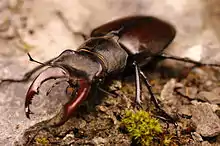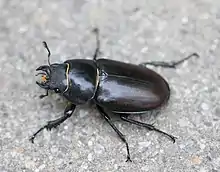Lucanus cervus
The European stag beetle (Lucanus cervus) is one of the best-known species of stag beetle (family Lucanidae) in Western Europe, and is the eponymous example of the genus. L. cervus is listed as Near Threatened by the IUCN Red List.[1]
| Stag Beetle | |
|---|---|
 | |
| Male | |
 | |
| Female | |
| Scientific classification | |
| Kingdom: | |
| Phylum: | |
| Class: | |
| Order: | |
| Family: | |
| Subfamily: | |
| Genus: | |
| Species: | L. cervus |
| Binomial name | |
| Lucanus cervus | |
| Synonyms[2] | |
| |
Taxonomy
L. cervus is situated in the genus Lucanus within the family Lucanidae. In the genus there are two subgenera: Lucanus Scopoli, 1763 and Pseudolucanus Hope and Westwood, 1845.[3] The species L. cervus contains four subspecies. The nominate subspecies L. cervus cervus (Linnaeus, 1758) was established via the original description of the species in 1758. The three latterly added subspecies are L. cervus judaicus Planet, 1900, L. cervus laticornis Deyrolle, 1864, and L. cervus turcicus Sturm, 1843.[2] L. cervus akbesianus 1896
Description

Sexually dimorphic, the males have enlarged mandibles and are larger than the females. Although the male's mandibles seem threatening, they are too weak to be harmful. Nevertheless, females can inflict a painful bite. The resemblance of the male's mandibles to the antlers of a stag, and their use in combat between males, much like with deer, gives the species its scientific and common names.
Adult size varies between different areas of its distribution, for example beetles from Spain, Germany, and the Netherlands are larger than those from Belgium or the UK.[4]
Distribution and habitat
L. cervus is widespread across Europe,[4] though it is absent from Ireland.[1] In Germany it is widespread, mainly in the south. In Hungary this species is widespread in the hilly and mountainous areas. In Romania it is widespread, especially in the hilly areas with sun exposed slopes. It also occurs in the European part of Turkey.[1] In Italy it is mainly distributed in northern and central regions.[5] In Spain and Portugal it is present only in the northern half of each country.[6][7] In Britain it is largely confined to the south-east of England, where it is widespread.[8] This species is now extinct in Denmark and Latvia.[9] It is also found in Caucasus, Asia Minor, Syria and west Kazakhstan.[1] Its range is currently only increasing in Croatia and Slovakia.[4]
L. cervus has been associated with a range of trees including those in the families oak (Quercus), lime (Tilia), beech (Fagus), willow (Salix) and certain species in other families including black poplar (Populus nigra), ash (Fraxinus excelsior), horse-chestnut (Aesculus hippocastanum), wild cherry (Prunus avium), and common walnut (Juglans regia).[10] Larval development sites were found in proximity of dead wood of the allochthonous Quercus rubra.[11]
Lifecycle

Adults appear during late May to the beginning of August, being most active in the evenings. Females lay their eggs in a piece of decaying wood deep in the soil. Stag beetle larvae, which are blind and shaped like a letter "C", feed on rotting wood in a variety of places, tree stumps, old trees and shrubs, rotting fence posts, compost heaps, and leaf mould. The larvae have a cream-coloured, soft, transparent body with six orange legs, and an orange head which is very distinct from the very sharp brown pincers. They have combs in their legs which they use for communication (stridulation) with other larvae. The larvae go through several instar stages, taking 4 to 6 years to become pupae.[12]


The work of entomologist Charlie Morgan during the late 1970s discovered that the pupae of the stag beetle live in the soil for about 3 months, then emerge in summer to awkwardly fly off to mate. Adults only live for a few weeks, feeding on nectar and tree sap. Their slow, lumbering flight, usually at dusk, makes a distinctive low-pitched buzzing sound. The males fly more readily than the females.
Behaviour and ecology
The natural reaction of the beetle to an approaching large object is to remain motionless, making them a good photographic subject.
Daily activity, use of space and detectability
In a primary ancient forest in northern Italy, stag beetle males were less elusive than females. Males were more frequently radio-tracked in flight, females mostly underground and in the proximity of deadwood. Males were mostly observed flying at sunset, and resting or walking on standing trees during the day. The combination of air temperature and humidity determined the optimal weather conditions for male flights. Flying at sunset, mostly performed by males, significantly increased the detectability of the species. [13] Stag beetles are shown to be more active during the first part of their adult lives. Males were more prone to disperse than females but the home range size did not differ between the sexes. Dividing the flight season in three intervals, the most active individuals were recorded during the first and the second ones (first and second half of June).[14]
Predators
Natural predators of L. cervus in Britain include cats, foxes, carrion crows, magpies and kestrels; these tend to strike at the most vulnerable stage in the beetle’s life cycle, when adults are seeking to mate and lay eggs.[9] In the case of magpies, they have been observed in the field as waiting for emergence on a single site; subsequently consuming the beetle's abdomen.[15]
In Italy, the main predator is the Hooded crow (Corvus cornix).[16]
Parasites
Mites in the order Monogynaspida (Suborder Uropodina) are phoretic (attached for the purpose of transportation) and have been observed attached to L. cervus as deutonymphs on the membrane of the joint between head and pronotum.[17]
Relationship to humans
Protection
L. cervus is listed as Near Threatened by the IUCN Red List.[1] Although this species is widely distributed in Europe, it is in significant decline in the north and central part of its range and future trends of European forests will pose serious threats to this species, thus making the species close to qualifying for Vulnerable.[1]
L. cervus is registered in the second appendix of the Habitats Directive of the European Union from 1992, which requires that member states set aside special areas of conservation. The species is also registered in the third appendix of the Convention on the Conservation of European Wildlife and Natural Habitats (Berne convention) of 1982 and Schedule 5 of the UK's Wildlife and Countryside Act 1981.[12]
References
- "Lucanus cervus". IUCN Red List of Threatened Species. 2017. 2017. Retrieved 2017-01-23.
- "Stag Beetle, Lucanus cervus (Linnaeus, 1758)". BioLib.cz. Retrieved 2017-07-05.
- "Genus. Lucanus Scopoli, 1763". BioLib.cz. Retrieved 2017-07-05.
- Harvey, D.J.; Gange, A.C.; James, C. J.; Rink, M (2011). "Bionomics and distribution of the stag beetle, Lucanus cervus (L.) across Europe". Insect Conservation and Diversity. 4: 23–38. doi:10.1111/j.1752-4598.2010.00107.x.
- Bartolozzi L.; Maggini L. (2006). "Insecta Coleoptera Lucanidae". In S. Ruffo; F. Stoch (eds.). Checklist and distribution of the Italian fauna. Museo Civico di Storia Naturale di Verona. pp. 191–192.
- López-Colón, J. I. (2000). "Familia Lucanidae". In Martín-Piera, F.; López-Colón, J. I. (eds.). Fauna Iberica Vol. 14: Coleoptera, Scarabaeoidea I. CSIC.
- Grosso-Silva, J.M. (1999). "Contribuição para o conhecimento dos lucanídeos (Coleoptera, Lucanidae) de Portugal". Boletín de la Sociedad Entomológica Aragonesa (in Portuguese). 25: 11–15.
- "Lucanus cervus (Linnaeus, 1758) [Stag Beetle]". National Biodiversity Network. Retrieved 2017-02-24.
- "About stag beetles". People's Trust for Endangered Species. 2017. Retrieved 2017-02-24.
- "Coleoptera >> Lucanidae >> Lucanus cervus (L.)". Database of Insects and their Food Plants (Biological Records Centre). Retrieved 2017-02-24.
- Tini, M.; Bardiani, M.; Campanaro, A.; Mason, F.; Audisio, P.; Carpaneto G.M. (2017). "Detection of stag beetle oviposition sites by combining telemetry and emergence traps". Nature Conservation. 19: 81–96. doi:10.3897/natureconservation.19.12678.
- "Lucanus cervus". Encyclopedia of life. Retrieved 2017-02-24.
- Tini, M.; Bardiani, M.; Campanaro, A.; Chiari, S.; Mason, F.; Maurizi, E.; Toni, I.; Audisio, P.; Carpaneto, G.M. (2017). "A stag beetle's life: sex-related differences in daily activity and behaviour of Lucanus cervus (Coleoptera: Lucanidae)". Journal of Insect Conservation. 21: 897–906. doi:10.1007/s10841-017-0029-5.
- Tini, M.; Bardiani, M.; Chiari, S.; Campanaro, A.; Maurizi, E.; Toni, I.; Mason, F.; Audisio, P.; Carpaneto, G.M. (2018). "Use of space and dispersal ability of a flagship saproxylic insect: a telemetric study of the stag beetle (Lucanus cervus) in a relict lowland forest". Insect Conservation and Diversity. 11: 116–129. doi:10.1111/icad.12260.
- Fremlin, m; Davidson, J.; Davidson, G. (2012). "Stag Beetle Predation by Magpies in a Colchester Garden" (PDF). Nature in North-East Essex: 81–85.
- Campanaro, A.; Toni, I.; Hardersen, S.; Grasso, D. A. (2011). "Monitoring of Lucanus cervus by means of Remains of Predation (Coleoptera: Lucanidae)". Entomologia Generalis. 33 (1): 79–89. doi:10.1127/entom.gen/33/2011/79.
- Hawes, C. (2010). "Hitchhiking a lift: Stag Beetles as Carriers of Mites" (PDF). White Admiral. 77: 16–17.
External links
| Wikimedia Commons has media related to Lucanus cervus. |
| Wikispecies has information related to Lucanus cervus. |
- stagbeetle.info Research site ran by Royal Holloway, University of London
- Biology of the Stag Beetle, translated from the Spanish article "de lo poco conocido y lo mucho por conocer"
- Brief illustrated look at the stag beetle
- 3D model of Lucanus cervus

